Jumping spiders are cool! They have interesting behaviors and cool tricks to survive. The Common Zebra spider is like a celebrity among them, often hanging out where people live, and you can spot it by its striking black-and-white stripes.
But there are also smaller spiders like Sitticus pubescens and Pseudeuophrys lanigera that live in similar places, though they are not as famous and do not have the same stripes. These spiders have special skills that help them live in their specific homes.
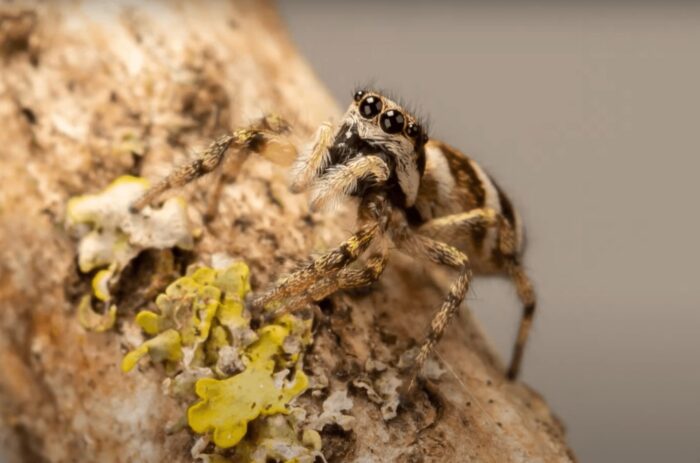
If you are curious about Zebra jumping spiders and want to dive deeper into their world, there is more to explore. Learn about their diet, habitat preferences, and unique hunting techniques. Discover how to care for them as pets, including details about the ideal enclosure.
The world of Zebra jumping spiders is full of fascinating facts, and the more you read, the more you will appreciate these awesome arachnids! Keep reading…!
About Zebra Spider:
Scientific Name:
The zebra spider, scientifically known as Salticus scenicus, is a familiar jumping spider found in the Northern Hemisphere. Its name comes from its eye-catching black-and-white colors.
The scientific name is derived from “Salticus,” which comes from the Latin word for “jump,” and “scenicus,” from the Greek word meaning “theatrical” or “of a decorative place.” This name highlights the spider’s lively and zebra-like appearance, making it stand out in its natural habitat.
Size and Appearance:
The Salticus scenicus, found in both males and females, sports a distinctive appearance with white markings on a dark brown to black background, usually ranging from 5 to 6 millimeters in body length.
One of their defining features is a visually striking zebra-like pattern on their abdomens. This pattern consists of four white stripes set against a black background, creating a distinctive and eye-catching appearance. The dark and white coloration is a result of flattened scales, similar to those on butterfly wings, which can appear iridescent in bright sunshine.
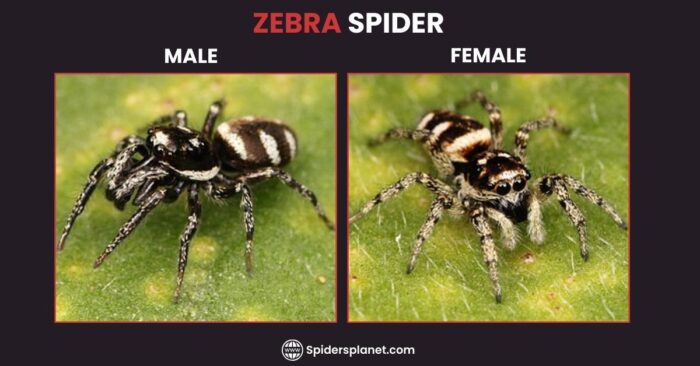
Like other jumping spiders, they have a distinctive square fronted cephalothorax (the front part of the body), and their face is prominently occupied by a row of four eyes—larger in size, especially the central pair. Two additional pairs of much smaller eyes are set farther back.
Male: Zebra jumping spider males stand out with larger chelicerae (fangs) compared to females. Males are usually smaller, measuring about 5 to 6 mm.
Additionally, the pedipalps, which are modified front legs, are more elongated in males. These characteristics contribute to the overall uniqueness of Salticus scenicus, making them easily recognizable in their habitat.
Female: Zebra jumping spider females are generally larger than males. Female zebra spiders typically range from 5 to 9 mm in length.
Zebra Jumping Spider Habitat:
Zebra Jumping spiders (Salticus scenicus) exhibit a diverse and widespread distribution, spanning Europe, North America, and parts of Asia, showcasing their adaptability to various environments. These arachnids are commonly found in open habitats like rock faces and shingle beaches, occasionally appearing on tree trunks.
Their inclination toward vertical surfaces extends to urban areas, where they adapt to human proximity by residing on garden fences and building walls.
Salticus scenicus demonstrate remarkable versatility by entering houses and can often be found in window corners, highlighting their adaptability to indoor environments and their widespread presence in human spaces.
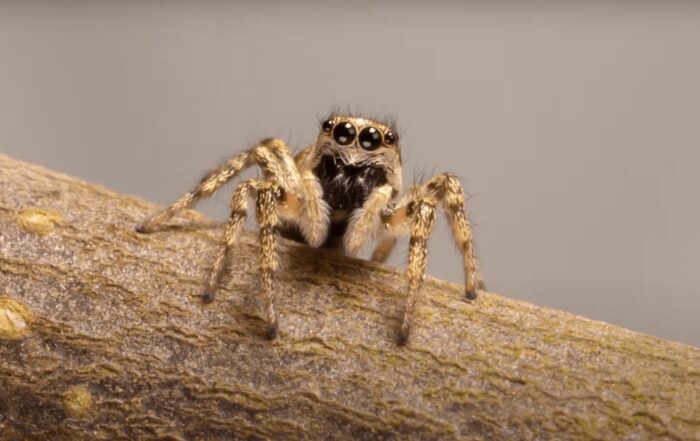
In comparison, related species, Salticus cingulatus and Salticus zebraneus, known as Zebra spiders, display subtle differences in their habitats and distributions.
Salticus cingulatus is widespread in Britain, favoring tree trunks and fence posts. Salticus zebraneus is more selective, preferring conifer trees, tall plants, and bushes, with distribution concentrated in the Thames corridor.
The Common Zebra Spider, recognizable by its black and white striping, is the predominant jumping spider near human habitations, contrasting with smaller, less common species like Sitticus pubescens and Pseudeuophrys lanigera, which lack the distinctive markings of the Common Salticus scenicus.
Related Post: Grass Spider: Appearance, Habitat, Lifecycle, Preventive Measures
Zebra Jumping Spider Diet:
Zebra spiders are awesome hunters! They like to eat smaller spiders and bugs. Surprisingly, they have been seen munching on mosquitoes almost twice their size and even smaller moths that are three times longer than them.
These spiders are like little ninjas – they use their big front eyes to spot their dinner and then sneak up slowly. When they are close enough, they pounce, just like a cat! Their super eyes help them figure out the right distance to jump and catch their food. So, these tiny spiders are not just cute; they’re also amazing hunters!
Reproduction in Zebra Jumping Spiders:
These black and white spiders have a specific schedule for their reproductive activities. Adult males are usually around from April to July, while females can be found from March to October. These spiders like to get romantic in late spring or early summer. The male woos the female with a peculiar dance, moving in a jerky, zig-zagging way and waving his front legs and big chelicerae (those are like his jaws) to catch her attention.
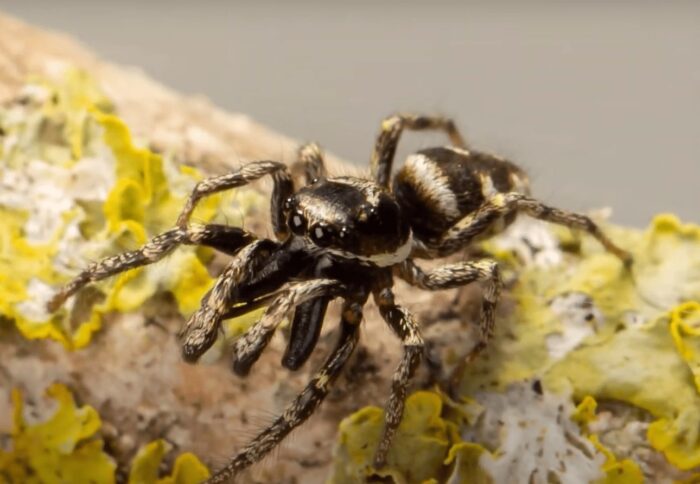
After their dance, the female goes to a cozy spot under rocks or debris to create a messy home. In this home, she lays about 15 to 25 eggs, protected in a silky sac. The female takes good care of these eggs until they hatch after three or four weeks.
Once the baby spiders, called spiderlings, come out, she looks after them until they grow up a bit. Then, she lets them go on their own. As the young spiders grow, they shed their skins about 9 or 10 times before becoming adults. They spend the winter as almost-adults and become full-grown spiders in the spring. That is the life cycle of these cool Salticus scenicus!
Catching Prey:
The Common Zebra spiders are quite the hunters and do not bother with making webs. Instead, they like to actively hunt on sunny surfaces. These spiders usually stay still until they sense movement from potential prey using their two pairs of small eyes on each side of their head. Once they spot something tasty, they turn to face it and move in a jerky way, either forward or backward.
To accurately judge the distance before pouncing, they use their four large front eyes, which can see in color and provide high-resolution binocular vision. It is like having super-eyes for hunting! You can even get them to jump by teasing them with a fly or small insect held in forceps. Before leaping, the spider attaches a line of silk to the surface, like a safety rope.
If the jump does not go as planned, they use this silk safety line to avoid a rough landing. These spiders are really cool and clever in their hunting techniques!
Zebra Jumping Spider As Pet:
Keeping a Zebra jumping spider as a pet can be a fascinating experience, as these small and active spiders are known for their intelligence and playful behavior. Here is a concise guide for potential pet owners:
Enclosure: For housing a Zebra jumping spider, a 10-gallon tank featuring proper ventilation and climbing spaces is ideal. Utilize coconut fiber or peat moss as substrate for a comfortable environment. Maintain the enclosure at a temperature ranging from 68-82°F, with humidity levels kept between 50-60%. These conditions create a suitable and comfortable habitat for your Zebra jumping spider, ensuring their well-being and contentment.
Diet: Zebra jumping spiders eat various insects such as flies, beetles, and moths. Offer live or freeze-dried insects every few days.
Handling: They are relatively docile and can be handled gently. Use a damp paintbrush to transfer them to your hand. Wash your hands thoroughly after handling.
Lifespan: Zebra jumping spiders typically live around 2 years.
Related Post: Knowing Your Jumping Spider Pet: A Comprehensive Guide
Zebra Jumping Spider Facts:
Zebra jumping spiders showcase a range of remarkable traits that contribute to their success in the arachnid world:
- Their exceptional vision, particularly from their large, forward-facing eyes, grants them unparalleled depth perception and binocular vision, crucial for precise prey tracking.
- These spiders are acrobatic experts, capable of leaping up to 20 times their body length using powerful hind legs as springs.
- Their cunning mimicry skills allow them to imitate other insects’ movements, enticing unsuspecting prey closer for a successful capture.
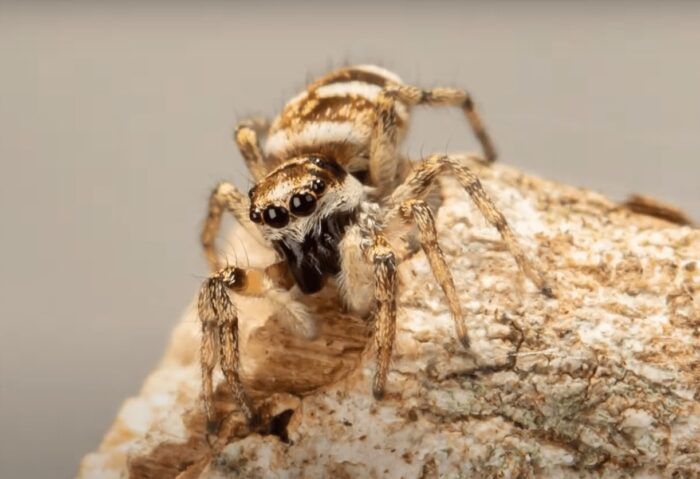
- Engaging in elaborate courtship rituals, these spiders showcase intricate dances and vibrations to attract mates, highlighting their social behaviors. Surprisingly intelligent, they demonstrate learning capabilities and memory retention, adapting to stimuli over time.
- Female Zebra jumping spiders exhibit meticulous care by constructing silk cocoons to protect their eggs, often hidden in discreet locations.
- Their adaptability extends to urban environments, where they thrive on walls, fences, and even inside homes, showcasing their resilience in diverse landscapes.
FAQs:
Do Zebra jumping spiders bite?
Zebra jumping spiders (Salticus scenicus) are not known to be aggressive, and they rarely bite humans. If a bite does occur, it is generally harmless and comparable to a mild bee sting. These spiders are more likely to retreat or jump away when approached rather than bite. However, as with any spider or insect, individual reactions to bites can vary, and some people may experience mild irritation or allergic reactions.
Are Zebra jumping spiders poisonous?
Zebra jumping spiders are not considered dangerous to humans. While they do possess venom for subduing their prey, the venom is not harmful to people. The fangs of Zebra jumping spiders are too small and their venom too mild to cause any significant harm to humans. In general, their bites are rare, and if they occur, they are usually harmless and result in mild, localized reactions similar to a bee sting.
Final Thoughts:
Zebra jumping spiders, with their striking black-and-white appearance, showcase remarkable behaviors and adaptations. From their intricate courtship dances to acrobatic leaps and intelligent hunting strategies, these spiders are fascinating creatures.
They adapt well to diverse environments, including urban spaces, and make interesting and relatively low-maintenance pets. Harmless to humans, their bites are comparable to a mild bee sting. Zebra jumping spiders contribute to the rich tapestry of the arachnid world with their unique characteristics and behaviors.




Leave a Reply